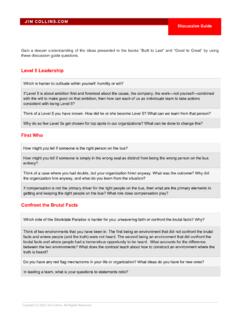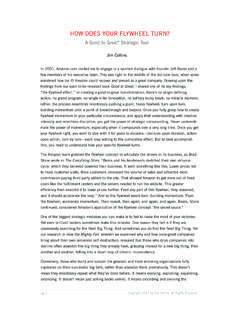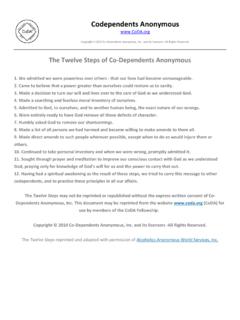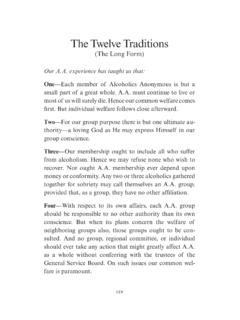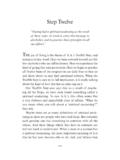Transcription of JIM’S TWELVE QUESTIONS
1 GOOD TO GREAT The Project DEVELOPED BY JIM COLLINS Greatness is not a function of circumstance. Greatness, it turns out, is largely a matter of conscious choice, and discipline. JIM S TWELVEQUESTIONSpg 1 Jim s TWELVE QuestionsJIM S TWELVE QUESTIONS DEVELOPED BY JIM COLLINS. RELEASE VERSION 2014 BY JIM COLLINS. ALL RIGHTS on the TWELVE QUESTIONS A Note from JimIn 1988, I had the great privilege to inherit teaching responsibility for a course on entrepreneurship and small business management at the Stanford Graduate School of Business. As I was preparing for my first year of teaching, I began to revise the syllabus for the course.
2 The opening line of the syllabus read something like, this will be a course on the mechanics and challenges of the entrepreneur and small business manager. For some reason, I impulsively changed the opening line to reframe the course around the question of what it would take to turn an entrepreneurial venture or small business into an enduring great company. I remember looking at that new opening sentence, and thinking to myself, Wow, I don t know anything about that. And thus began what would become a passionate quest a quarter century of research, writing, and thinking about the question of what it takes to build an enduring great company or social sector enterprise.
3 The result is more than 6,000 years of combined corporate history in a research database, six books, a range of articles, and a monograph translating some of the key ideas into the challenges faced by social sector leaders. These works included Built to Last (co-authored with Jerry Porras), Great by Choice (co-authored with Morten Hansen), Beyond Entrepreneurship (co-authored with Bill Lazier), How the Mighty Fall, and the cornerstone work Good to Great, along with its compan-ion monograph Good to Great and the Social Sectors. In 2012, I began to get a lot of QUESTIONS from people who wanted to engage with the body of work, not just one book, so that they would have the best chance to build a great enterprise.
4 The QUESTIONS were along the lines of: Where as a leadership team should we begin? Is there a best sequence to the reading, or to engaging with the concepts? What is the best way to challenge a team to engage with the full body of work? After reflecting on these QUESTIONS , I decided to construct a sequence of TWELVE QUESTIONS that would serve as a mechanism of disciplined thought for a leader and his or her team. The QUESTIONS are designed to help you efficiently access the full body of work, in what I believe is a highly-effective sequence, along with readings corresponding to each question .
5 I encourage you and your team to discuss one question per month, to fill out an entire year of disciplined thought. The most powerful results will come from repeating the cycle, rigorously hitting each question at least once per year. At the end of a year, you can further self-assess using the Good to Great Diagnostic Tool, available at Jim CollinsThe Good to Great Project LLCB oulder, COpg 2 Jim s TWELVE QuestionsWhat Defines Great Before jumping into the TWELVE QUESTIONS , let me first address the question : what is a great enterprise, be it a great company or a great social sector enterprise?
6 Not how you build one, but what is a great organization what are the criteria of greatness? There are three tests: Superior Results, Distinctive Impact, and Lasting Endurance. Superior ResultsIn business, performance is defined by financial results return on invested capital and achievement of corporate purpose. In the social sectors, performance is defined by results and efficiency in delivering on the social mission. But whether business or social, you must achieve top-flight results. To use an analogy, if you are a sports team, you must win championships; if you don t find a way to win at your chosen game, you cannot be considered truly great.
7 Distinctive ImpactA truly great enterprise makes such a unique contribution to the communities it touches, and does its work with such unadulterated excellence that, if it were to disappear, it would leave a gaping hole that could not be easily filled by any other institution on the planet. If your organization went away, who would miss it, and why? This does not require being big; think of a small but fabulous local restaurant that would be terribly missed if it disappeared. Big does not equal great, and great does not equal EnduranceA truly great organization prospers over a long period of time, beyond any great idea, market opportunity, technology cycle, or well-funded program.
8 When clobbered by setbacks, it finds a way to bounce back stronger than before. A great enterprise transcends dependence on any single extraordinary leader; if your organization cannot be great without you, then it is not yet a truly great organization. Finally, I caution against ever believing that your organization has achieved an end-state of greatness. To be built to last means embracing the idea that good to great is never done. No matter how far we have gone, or how much we have achieved, we are merely good relative to what we can do next.
9 Greatness is an inherently dynamic process, not an end point. The moment you think of yourself as great, your slide toward mediocrity will have already begun. JIM S TWELVE QUESTIONS DEVELOPED BY JIM COLLINS. RELEASE VERSION 2014 BY JIM COLLINS. ALL RIGHTS 3 Are we willing to strive for Level 5 Leadership, and to embrace the 10X behaviors needed to build a great company or social sector enterprise? Reading: Good to Great, Chapters 1, 2; Great by Choice, Chapters 1, 2; article at : Built to Flip For leaders in the social sectors, first read: Good to Great and the Social Sectors :Do we practice the principle of First Who, with the Right People on the Bus and in the right seats?
10 Reading: Good to Great, Chapter 3; How the Mighty Fall, Appendix :How can we accelerate clicks on the Flywheel by committing to a 20 Mile March? Reading: Good to Great, Chapters 7, 8; Great by Choice, Chapter :What are the Brutal Facts, and how can we better live the Stockdale Paradox? Reading: Good to Great, Chapter :What do we understand so far about our Hedgehog Concept what we are fanatically passionate about, what we can (and cannot) be the best at, and what drives our economic or resource engine? Reading: Good to Great, Chapters 5, :Where should we place our big bets, based on the principle Fire Bullets, then Cannonballs blending creativity and discipline to scale innovation?
